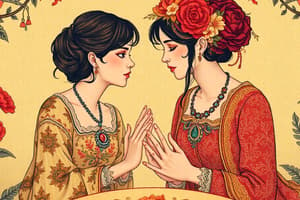Podcast
Questions and Answers
What is a key time period highlighted as significant for understanding the nature of war since 1945?
What is a key time period highlighted as significant for understanding the nature of war since 1945?
- 1970
- 1945 (correct)
- 1990
- 1989
According to the content, what has happened to the Clausewitzean image of war since 1945?
According to the content, what has happened to the Clausewitzean image of war since 1945?
- It remains unchanged in its influence on military strategy.
- It has become more relevant than ever.
- It has become increasingly divorced from most armed conflicts. (correct)
- It has been universally accepted as a solution for all wars.
What type of wars does the content suggest have been the most common since 1945?
What type of wars does the content suggest have been the most common since 1945?
- Mixed civil-international wars
- Civil wars within states (correct)
- Interstate wars
- Nuclear wars
What does the content imply about the relevance of concepts derived from European and Cold War experiences?
What does the content imply about the relevance of concepts derived from European and Cold War experiences?
Which wars are cited as examples of Clausewitzean wars still occurring after 1945?
Which wars are cited as examples of Clausewitzean wars still occurring after 1945?
What does Azar's theory suggest about the emergence of leadership roles during conflicts?
What does Azar's theory suggest about the emergence of leadership roles during conflicts?
According to Azar, what happens to political structures over time in prolonged conflicts?
According to Azar, what happens to political structures over time in prolonged conflicts?
What factor does Azar identify as a primary source of major armed conflict?
What factor does Azar identify as a primary source of major armed conflict?
What significant change did Azar not consider in his work?
What significant change did Azar not consider in his work?
What does Zartman's conclusion imply about conflicts after the Cold War?
What does Zartman's conclusion imply about conflicts after the Cold War?
What aspect of global conflict interpretation is highlighted in relation to Azar's analysis?
What aspect of global conflict interpretation is highlighted in relation to Azar's analysis?
What does Azar's PSC analysis attempt to synthesize?
What does Azar's PSC analysis attempt to synthesize?
What is primarily suggested as a cause of ethnic conflict in the context provided?
What is primarily suggested as a cause of ethnic conflict in the context provided?
What happens to groups as they begin to fear for their safety?
What happens to groups as they begin to fear for their safety?
Which factor complicates governance and can lead to increased conflict according to the content?
Which factor complicates governance and can lead to increased conflict according to the content?
What emotional states contribute to the polarization of society as mentioned in the context?
What emotional states contribute to the polarization of society as mentioned in the context?
What is indicated as a potential result of information failures among groups?
What is indicated as a potential result of information failures among groups?
What has been identified as a key element in driving groups apart during crises?
What has been identified as a key element in driving groups apart during crises?
What concept is softened in the discussion regarding the motivations for conflict?
What concept is softened in the discussion regarding the motivations for conflict?
What is likely to happen as a result of weak state governance according to the information given?
What is likely to happen as a result of weak state governance according to the information given?
Who reinforces the fears of groups according to the suggested model?
Who reinforces the fears of groups according to the suggested model?
What does the state represent for most people despite globalization pressures?
What does the state represent for most people despite globalization pressures?
Which correlation has been observed in relation to protracted conflict?
Which correlation has been observed in relation to protracted conflict?
What type of conflict is associated with safeguarding communal needs?
What type of conflict is associated with safeguarding communal needs?
What can be a consequence of rapid urbanization as mentioned in the content?
What can be a consequence of rapid urbanization as mentioned in the content?
What is true about failed states in the context of conflict?
What is true about failed states in the context of conflict?
How might uneven development contribute to conflict according to the information provided?
How might uneven development contribute to conflict according to the information provided?
Which factor is associated with an increase in untrained and unemployed young males?
Which factor is associated with an increase in untrained and unemployed young males?
What role does the state play in the tension between globalization and local sentiments?
What role does the state play in the tension between globalization and local sentiments?
What might generate conflict even in states with reasonable levels of development?
What might generate conflict even in states with reasonable levels of development?
Flashcards
Interstate War
Interstate War
Wars fought between countries. Think traditional warfare.
Intrastate War
Intrastate War
Wars fought within a country, often between government and rebels.
Clausewitzean War
Clausewitzean War
The idea that warfare is about rational decision-making and achieving political objectives.
Mixed Civil-International War
Mixed Civil-International War
Signup and view all the flashcards
Nuclear Stalemate
Nuclear Stalemate
Signup and view all the flashcards
Social Implosion
Social Implosion
Signup and view all the flashcards
Pluralist Framework
Pluralist Framework
Signup and view all the flashcards
Vested Interests in War
Vested Interests in War
Signup and view all the flashcards
Disintegration of the Bipolar World
Disintegration of the Bipolar World
Signup and view all the flashcards
Uncertainty Following the Old Order
Uncertainty Following the Old Order
Signup and view all the flashcards
Neo-realism
Neo-realism
Signup and view all the flashcards
Caricature
Caricature
Signup and view all the flashcards
Process Dynamics of PSC Escalation
Process Dynamics of PSC Escalation
Signup and view all the flashcards
Collective Fears of the Future
Collective Fears of the Future
Signup and view all the flashcards
State Decay
State Decay
Signup and view all the flashcards
Problems of Credible Commitment
Problems of Credible Commitment
Signup and view all the flashcards
Security Dilemma
Security Dilemma
Signup and view all the flashcards
Political Entrepreneurs
Political Entrepreneurs
Signup and view all the flashcards
Political Memories
Political Memories
Signup and view all the flashcards
Between-Group and Within-Group Interactions
Between-Group and Within-Group Interactions
Signup and view all the flashcards
Greed and Grievance
Greed and Grievance
Signup and view all the flashcards
State as a mediator between globalization and fragmentation
State as a mediator between globalization and fragmentation
Signup and view all the flashcards
State as a primary source of identity
State as a primary source of identity
Signup and view all the flashcards
State's monopoly on sovereignty
State's monopoly on sovereignty
Signup and view all the flashcards
State as the prize in conflict?
State as the prize in conflict?
Signup and view all the flashcards
State control even in 'failed' states
State control even in 'failed' states
Signup and view all the flashcards
Uneven development and conflict
Uneven development and conflict
Signup and view all the flashcards
Poverty, urbanization, and conflict
Poverty, urbanization, and conflict
Signup and view all the flashcards
Inequity and conflict
Inequity and conflict
Signup and view all the flashcards
Terrorism and the state
Terrorism and the state
Signup and view all the flashcards
Study Notes
Contemporary Conflict Resolution
- This book is dedicated to conflict resolution founders and new conflict resolvers globally.
- It is a second edition.
- Authors: Oliver Ramsbotham, Tom Woodhouse, and Hugh Miall.
Understanding Contemporary Conflict
- Historians struggle to trace subtle influences that lead to violence.
- Conflict analysis (polemology) is essential for conflict resolution.
- Theories and frameworks: General theories highlight generic aspects of conflict, while specific political/historical explanations examine particular conflicts.
- A 'unified theory' for post-Cold War conflicts is likely unlikely due to varied conflict types globally.
- Conflict theories can be internal (protagonists' nature), relational (interactions), or contextual (surrounding conditions).
- Early modern European thinkers like Machiavelli and Hobbes explored conflict motivations.
- Political bias influences conflict analysis.
- Different perspectives on the Northern Ireland conflict exist (third party/ internal conflict vs. nationalist/unionist views.)
- Protracted Social Conflicts (PSC): These are studied as a form of conflict which is characterized by ongoing and repetitive violence.
- Azar's theory of PSCs evaluates domestic social roots of conflict.
- Post 1945 conflicts focus on statehood and governance.
- Conflict resolution approaches should consider evolving forms of conflict since 1945. Some research focuses on interstate conflict and its sources. However, post-1990s analysis has moved away from that paradigm, and now considers internal conflicts, or civil wars.
Edward Azar's Theory of Protracted Social Conflict
- Azar's work emphasized the internal, social roots of conflicts.
- Azar focused on 'basic needs' (security, development, political access, and identity) and their importance in conflict causation.
- He argued that conflict is closely tied to problems of governance and states.
- He noted international linkages and external influence on domestic conflict.
- These conflicts are characterized by a lack of clearly defined start and end points.
- Azar's theory analyzes the dynamics of chronic societal conflicts.
Contemporary Conflict and Resolution
- Post-Cold War conflicts differ from previous eras.
- 'New wars' and their various causes are discussed (economic interests, etc.).
- The role of resources, identity, and governance are key issues in conflicts today.
- Azar's ideas are situated in the context of global trends since 1945 (economic factors, etc.)
- Different approaches to conflict exist, including global ones (e.g., Huntington's "Clash of Civilizations")
- Analyses of conflict from a regional perspective highlight the significance of intergroup struggles.
- State-level analysis examines the impact of weak states, power struggles, and political repression on internal conflicts.
- Conflict is also impacted by the interplay of individual and elite motivations.
Proximate Causes of Internal Conflicts
- These are internal factors (bad leaders, domestic problems) and external factors (bad neighbors).
Studying That Suits You
Use AI to generate personalized quizzes and flashcards to suit your learning preferences.
Related Documents
Description
Explore the essential concepts and frameworks surrounding contemporary conflict resolution as established by the founders and new practitioners in the field. This quiz delves into the complexities of conflict analysis and the historical perspectives that shape our understanding of violence and conflict management.




